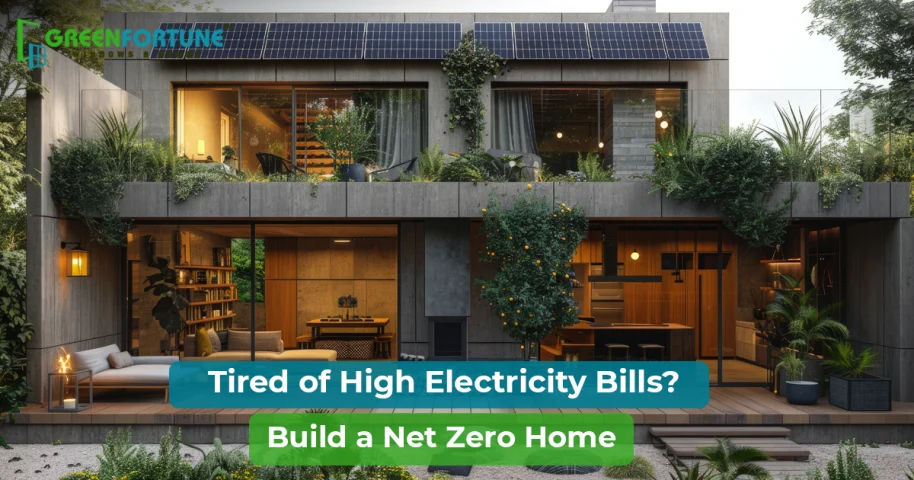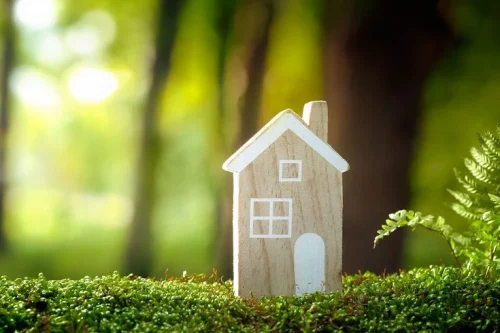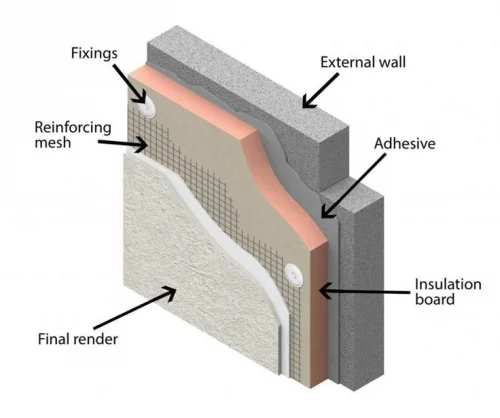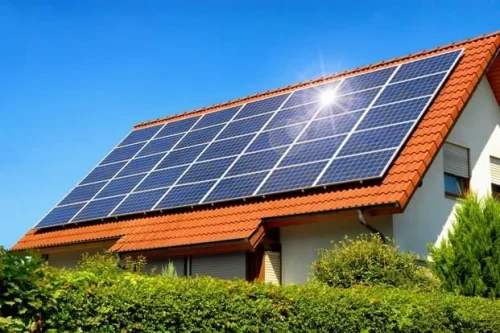
Lime Plaster Vs Cement Plaster: Which Is Better For Indian Homes?
July 24, 2025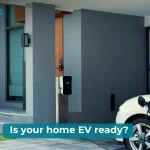
How to Build Your EV-Ready Homes in India: A Step‑by‑Step Guide
July 25, 2025Living in a house where you don’t pay electricity bills used to sound like science fiction. But not anymore. People are switching to net zero energy homes in India, where the home produces as much energy as it uses, mostly using solar.
It’s not just about being eco-friendly. It’s about cutting energy costs, building smarter, and staying prepared for rising power rates. And guess what? You don’t need a luxury villa to do it.
If you’re building a home or even planning a renovation, here’s how to make it net zero—what it costs, what to use, and why it’s totally worth it.
Table of contents
- Why Net Zero Homes Make Sense in India
- Choose the Right Location and Orientation
- Use Insulated Walls and Smart Materials
- Design a Cool, Reflective Roof
- Install Energy-Efficient Windows
- Choose Energy-Efficient Appliances
- Install a Rooftop Solar System
- Track Your Usage
- Budget for a Net Zero Energy Home in India
- Can You Convert an Existing Home?
- Final Thoughts
- Looking To Upgrade Your Home With Durable, Energy-Efficient Windows?
- FAQs
What Is a Net Zero Energy Home?
A net zero energy home is a building that produces as much power as it consumes. That means by the end of the year, your electricity usage is fully balanced by what your solar panels produce.
These homes are designed to:
- Use less electricity
- Generate their own power (mostly via solar)
- Keep the monthly bill at or near zero
In simple words, it’s a zero electricity bill home that runs smarter, not harder.
Why Net Zero Homes Make Sense in India
Here’s why net zero energy homes in India are catching on fast:
- Power bills are going up every year
- Cities are getting hotter, which means more cooling needs
- Solar panel costs have dropped by 60% in the last decade
- Government subsidies and net metering make solar a smart investment
Plus, most Indian cities get 300+ sunny days a year — a dream for anyone planning a solar powered home in India.
Choose the Right Location and Orientation
The plot you pick matters. A lot.
- Try to choose a location with direct sun exposure (south-facing roofs are ideal)
- Avoid tall buildings or trees that shade the rooftop
- East and north-facing windows work well to bring in light, but reduce heat
The right direction reduces heat load and makes solar panel placement easier.
Use Insulated Walls and Smart Materials
Most homes lose energy through poorly built walls.
For net zero energy homes in India, insulation is key. That means:
- Use AAC blocks (lightweight, insulating, and fire-resistant)
- Add wall insulation boards if your area gets extreme heat or cold
- Use lime plaster or mud plaster to regulate indoor temperature
Good walls reduce the need for cooling by 30–40%.
Design a Cool, Reflective Roof
The roof takes in the most heat. In net zero homes, it becomes part of your energy solution.
- Use reflective or white tiles to bounce off sunlight
- Install rooftop solar panels to generate power
- Add a rooftop garden if possible—it reduces heat and improves air quality
In many sustainable home design India projects, green rooftops are now standard.
Install Energy-Efficient Windows
Windows play a major role in heat gain or loss.
Choose:
- Double-glazed windows with low-E or energy-saving glass
- uPVC frames for airtight sealing
- External shading like chajjas or wooden screens
Good windows reduce air conditioner use significantly, which helps you reach net zero more easily.
Choose Energy-Efficient Appliances
Once your structure is ready, it’s time to focus on what goes inside. Even the best-built home won’t stay net zero if you’re running power-hungry appliances all day.
Here’s what to choose:
- Inverter air conditioners – they use 30–50% less energy than regular ones
- 5-star fans, fridges, and washing machines – don’t buy anything below a 3-star rating
- LED lights only – cheaper and cooler in the long run
- Induction cooktops – if you’re going fully electric
Also, use motion sensors or timers for garden lights or bathrooms — these tiny changes reduce wasted energy.
Install a Rooftop Solar System
This is the core of every net zero energy home in India.
You’ll need:
- Solar panels (typically 3–5 kW for a 2–3 BHK home)
- On-grid system with net metering (sends excess energy back to the grid)
- Or, off-grid system with batteries (if you want full energy independence)
Here’s a basic solar system cost breakdown for 2025:
Solar System Size | Daily Units Generated | Approx Cost (with installation) |
3 kW | 12–14 units/day | ₹1.7–2 lakh |
5 kW | 20–22 units/day | ₹2.5–3.3 lakh |
10 kW | 40–45 units/day | ₹4.5–5.5 lakh |
If your monthly usage is around 300–400 units, a 5 kW system is usually enough. Add a solar battery if your area has frequent power cuts.
Thanks to net metering, you’ll get credit for extra power sent back to the grid. This is what makes zero electricity bill homes possible.
Track Your Usage
Many net zero homeowners use smart meters or mobile apps to track how much energy is being used vs produced.
Apps like SolarEdge, Home Assistant, or even your solar provider’s dashboard can give you daily reports. It’s motivating to see your usage drop and your savings grow.
Budget for a Net Zero Energy Home in India
Let’s talk numbers. Here’s a basic cost estimate for building a 2–3 BHK net zero home in 2025 (1200–1500 sq ft):
Component | Estimated Cost |
Insulated walls + windows | ₹4–5 lakh |
Solar panels (5 kW) | ₹2.5–3.3 lakh |
Energy-efficient appliances | ₹1.5–2 lakh |
Smart lighting and automation | ₹30,000–₹70,000 |
Roof coating/green roofing | ₹50,000–₹1 lakh |
Total Extra Cost Over Regular Home | ₹9–12 lakh |
Note: These are one-time costs. Your savings begin immediately and keep compounding.
On average, net zero homeowners in India recover their investment in 5–6 years, thanks to electricity bill savings.
Can You Convert an Existing Home?
Yes — while it’s easier to build net zero from scratch, you can retrofit an old house too.
Here’s what to start with:
- Replace windows with energy-efficient glass
- Insulate the roof and external walls
- Switch to inverter appliances
- Add a rooftop solar system with net metering
Many architects now offer sustainable home design India packages for retrofits. It won’t be 100% zero right away, but even a 50–70% cut in energy use is huge.
Final Thoughts
Net zero energy homes in India are no longer rare experiments — they’re the smarter way to build. The climate is ideal, solar costs are falling, and new materials make it easier than ever.
Whether you’re building from scratch or planning a smart retrofit, think long-term. You won’t just save money — you’ll build a home that’s cleaner, cooler, and fully future-proof.
In the next five years, zero electricity bill homes won’t be the exception. They’ll be the standard. Why not be ahead of the curve?
Looking To Upgrade Your Home With Durable, Energy-Efficient Windows?
TheGreenFortune.com offers premium-quality uPVC doors and windows designed for Indian weather. They block heat, reduce noise, and come with UV protection that lasts for years. Whether you’re renovating or building new, these windows make your space smarter and cooler.
Visit Green Fortune to explore styles, get expert advice, and make your home future-ready.
FAQs
- Can net zero energy homes in India work during monsoon or cloudy days?
Yes, they can. Solar systems still generate power even on cloudy days, though at reduced efficiency. With net metering or battery backup, the power supply stays balanced year-round. - Are net zero homes only possible for independent houses, not apartments?
No, even apartment owners can reduce energy usage and add solar where permitted. Shared rooftop solar, better insulation, and efficient appliances can make a big difference in flats, too. - Do net zero homes require government approvals or special certifications?
Not necessarily. While there are green certifications like GRIHA or IGBC, they’re optional. You can build a net zero energy home in India without extra legal paperwork if you plan well.







